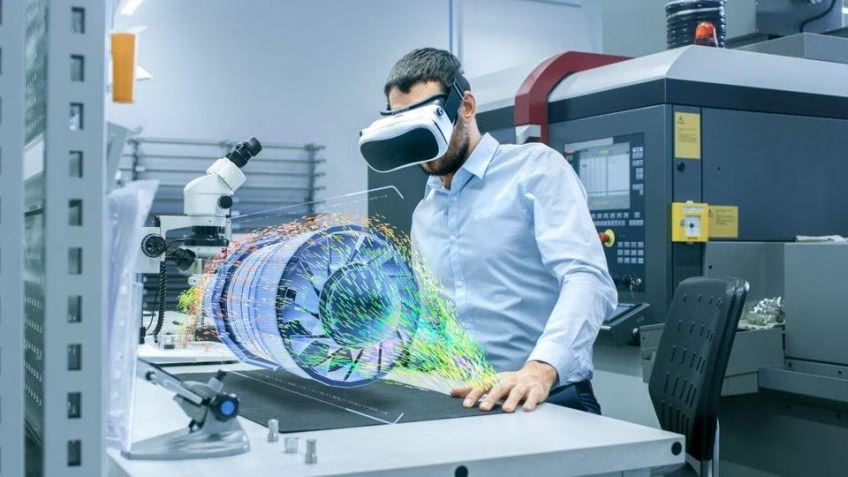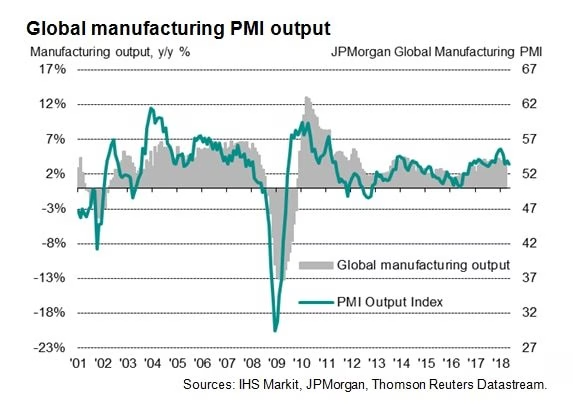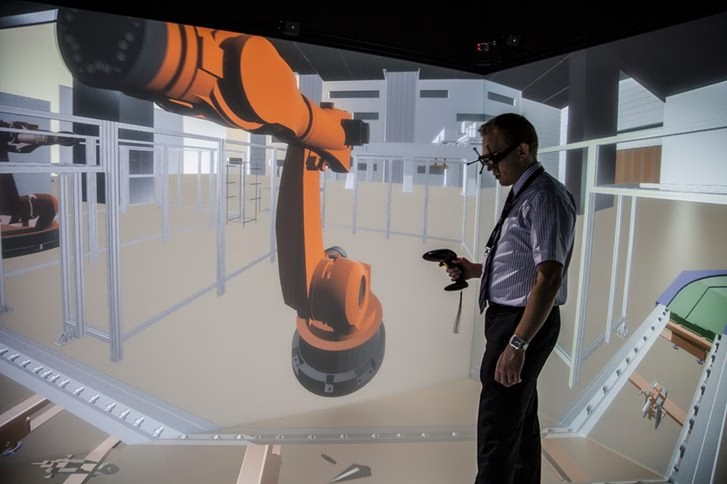
Application of Virtual Reality in Manufacturing
Wondering about the application of virtual reality in manufacturing?
This is a lucrative market with lots of opportunities to be explored.
According to a study done by Fior Markets, "the Global VR Market is Expected to Reach USD 56.25 Billion by 2025."
How Is the Health of the Global Manufacturing Industry?

At the time of writing this article, all indications point to a crucial period ahead for the global manufacturing industry. Consider the following statistics:
- UNIDO reported that in industrialized countries, MVA grew by 2.3% in 2018 compared to 2.6% in 2017. The developing and emerging economies saw MVA growth of 3.8% in 2018, compared to 4.1% in 2017.
- Another group of experts forecasts that the global manufacturing industry will grow by 0.7% in 2019, instead of the 2.5% growth they had earlier projected. Read this report in “Global manufacturing economy to stall in 2019; Europe dipping into the red…”.
The Challenges Facing the Manufacturing Industry
The global manufacturing industry faces several challenges, and these are as follows:

Get a complimentary discovery call and a free ballpark estimate for your project
Trusted by 100x of startups and companies like
- Shortage of skilled personnel: The industry is staring at a shortage of skilled personnel, and 2-3.5 million manufacturing jobs could lie vacant by 2025.
- Project management: Global headwinds are causing the manufacturing industry to slow down, however, the manufacturing businesses need to remain competitive by innovating and improving their operational efficiency. Project management was always crucial in this industry, and it‘s even more crucial now.
- Globalization: While globalization allows businesses to find talent in newer geographies, it also increases competition.
- Keeping up with new technologies: New technologies like the Industrial Internet of Things (IIoT), Robotics, Machine Learning (ML), etc. represent significant opportunities, however, businesses must keep pace with them. Considering the shortage of skilled personnel, that can be hard!
- Security: Emerging technologies predominantly use Cloud computing, and cyber-attackers are always prowling around to exploit security vulnerabilities.
VR Use Cases in the Manufacturing Industry
Given the shortage of skilled personnel and the need to innovate at speed and scale, it‘s not surprising that VR has significant use cases in the manufacturing industry. Take a look at the following examples:
- Product design: Industries like the automobile, defense, aerospace, etc. have a complex design and engineering process for their products since the products themselves are complex. VR helps in prototyping, which improves the design process. For e.g., Ford and Boeing are already using VR in their design process.
- Workplace design and layout: Modern manufacturing uses automation extensively, however, designing such manufacturing facilities isn‘t easy. Design errors can have a serious impact including safety hazards for personnel. Businesses can use VR to model their facilities first since this helps them to identify risks.
- Designing safer equipment: Quite like designing safer manufacturing facilities, businesses can also take advantage of VR to design safer equipment.
- Remote maintenance and servicing of equipment: Types of equipment used in the manufacturing industry are often critical, therefore, quick response is important when they break down. VR allows equipment manufacturers to remotely inspect the equipment, and this improves the response time. Manufacturers can also use VR for remote maintenance.
- Training: Training for specialized hands-on manufacturing jobs can be costly due to the lack of specialized trainers, moreover, distributed operations add to this cost. With VR, manufacturing businesses can reduce training costs.
Interest in VR on the Part of the Manufacturing Industry
The manufacturing industry is already showing a significant interest in VR, and the following pieces of statistics illustrate that:
- Aerospace giant Lockheed Martin has found that VR has helped their engineers to achieve a high degree of accuracy in their work, moreover, they can now work faster.
- An Allied Market Research report forecasts that between 2018 and 2025, the manufacturing industry will be the 3rd biggest driver for the growth of VR and Augmented Reality (AR).
- A PwC study found that 1 in every 3 US manufacturing companies is adopting VR/AR. Read more about this survey in “For US manufacturing, virtual reality is for real”.
How to Create a VR App for the Manufacturing Industry?

I will now explain the steps involved in creating a VR app for the manufacturing industry, and these steps are as follows:
1. Agree on the project scope
You would need to work with your business and IT stakeholders to agree on the use case, e.g., workplace design and layout, prototyping for product design, training, etc. I recommend that you offer a web app, an Android app, and an iOS app with the features pertaining to the use case you select.
2. Build a project team
You will need to onboard the project manager (PM), IT architect, and business analysts first so that you can start the project requirements analysis and planning. Subsequently, you need to hire UI designers, VR developers, web developers, Android developers, iOS developers, testers, and DevOps engineers.
A project to develop a VR app for a manufacturing company could be a strategic project, therefore, you should onboard a field expert development team. Read “Freelance app development team vs. field expert software development teams” to gain more insights into this.
VR developers need the following skills and competencies:
- Knowledge of SDLC, development best practices, testing best practices, and DevOps best practices.
- Expertise with managed cloud services platforms and popular VR development kits;
- A collaborative attitude.
Our guide “How to Hire VR Developers – the ultimate checklist” can help you.
3. Project methodology, approach, and estimation
A VR app for manufacturing will have a well-defined set of features, and the visibility for such a project is high, thus requiring thorough reviews. Given this, I recommend that you use the Waterfall SDLC model for this project, and you can read more about it in “What is software development life cycle and what do you plan for?”.
I recommend that you use Platform-as-a-Service (PaaS) and Mobile-Backend-as-a-Service (MBaaS) platforms for developing web and mobile apps, respectively. You should also use a reputed VR development kit since this would expedite the project, as I have explained in “What is the best development approach to guarantee the success of your app?”.
You need to estimate the following cost elements to arrive at an estimate for the project:
- Development manpower inclusive of phases like requirements analysis, design, development, testing, deployment, and maintenance;
- Platforms, VR development tools, and testing tools;
- Administrative costs, e.g., hiring, travel, etc.
Our guide “How much does it cost to build a VR app?” can help you with this estimation.
4. Sign-up for the required managed cloud services
You should use a PaaS platform for web app development since such platforms offer the following advantages:
- You don‘t need to manage the cloud infrastructure since the PaaS provider manages the infrastructure, networking, operating system, middleware, and runtime environment.
- Your team can focus on coding, and it‘s easy to integrate databases and 3rd party APIs.
- PaaS platforms offer robust DevOps tools, moreover, their application performance monitoring (APM) and auto-scaling solutions help you to scale your app.
I recommend that you use AWS Elastic Beanstalk, i.e., the PaaS offering from AWS for this project.
Hire expert developers for your next project
1,200 top developers
us since 2016
I also recommend that you use an MBaaS platform for mobile app development, which helps you in the following ways:
- MBaaS providers manage the cloud infrastructure, persistent storage, etc., therefore, you don‘t need to develop and manage the mobile backend.
- It‘s easy to integrate 3rd party APIs, furthermore, you can easily implement features like user management and security when you use an MBaaS platform.
- Scaling your app is easier when using an MBaaS platform.
For this project, I recommend that you use AWS Amplify. It‘s the MBaaS offering from AWS.
5. Get a VR development kit
Using a VR development kit can expedite your project significantly since you can implement the core features easily. I recommend that you use Virtual Reality Toolkit, a completely free VR engine released under the MIT license.
VRTK supports a number of solutions, such as locomotion within the virtual space, interactions like touching, grabbing, and using objects, interaction with Unity3D UI elements, 2D and 3D controls, etc., therefore, it‘s the right choice for a VR development kit.
You need to consult this extensive documentation to get started with using VRTK
6. Sign-up for a test automation aid
The web app will need to run on different browsers, moreover, the mobile apps will need to work with different devices.
You need to the apps against different browsers and mobile devices, therefore, I recommend that you sign-up for the Mobile Device & Browser Lab from Experitest. You can access this lab on Cloud, and integrate with popular open-source testing frameworks you use.
7. Designing the UI
The VR app needs a user-friendly UI, therefore, you should use the appropriate guidelines and best practices. I recommend the following resources:
- “User interface design guidelines: 10 rules of thumb” for the web app UI design;
- Human Interface Guidelines for the iOS app UI design;
- Material design guidelines for the Android app UI design.
8. Developing the web app
I recommend that you use Node.js for web app development since this open-source runtime environment enables the development of scalable and performant web apps.
A growing and vibrant Node.js developer community creates many open-source tools and frameworks, and this helps programmers to achieve higher productivity.
You need to take the following steps to develop the web app:
- Use Eclipse IDE, along with this Node.js plugin to code the app.
- Follow this AWS guide to integrating database resources in your code.
- Integrate the VRTK assets and APIs.
- Test and deploy the app using the DevOps tools on AWS Elastic Beanstalk. You can get comprehensive guidance for this in “Deploying Node.js applications to AWS Elastic Beanstalk”.
9. Code, test, and publish the Android app
You should consider developing the Android app using Java since many Android developers are already very experienced with this language.
Developing an Android app involves the following steps:
Hire expert developers for your next project
- Your team should use Android Studio since this is a popular IDE for Android development.
- The team needs to integrate Amazon Sumerian with the code.
- You should use Espresso to test the app, moreover, you also need to use the Experitest mobile device lab to access a wide range of devices.
- After thorough testing, publish the app to Google Play, by following these instructions.
10. Developing the iOS app
I recommend that you use Objective-C for coding the iOS app since most programmers developing apps for Apple platforms know this feature-rich language. Developing the iOS app involves the following steps:
- Code the app using Xcode, the IDE that developers for Apple platforms use.
- Integrate Sumerian assets and APIs in the app.
- Test the app using XCTest, moreover, you should also use the Experitest mobile device lab.
- Once you have tested the app thoroughly, follow this guide to publish it to the Apple App Store.
Planning a VR App for Your Manufacturing Business?
Platforms, tools, frameworks, and guidelines can simplify the project, however, a project to develop a VR app for your manufacturing business is a complex one.
Consider taking help from a professional software development company, moreover, read our guide “How to find the best software development company?” to learn how you should select one.
If you are developing a VR app for manufacturing business and need to scale your team with additional skills and expertise then take a moment to tell us about your project requirements here.
One of our dedicated tech account managers will be in touch to show you similar projects we have done before and share how we can help you.
Further Reading
Here are a few articles that might also interest you:
5 Ways Artificial Intelligence is Impacting the Automotive Industry
10 Java Performance Monitor Tools for 2021 - DevTeam.Space
10 Examples of Using Machine Vision in Manufacturing I DevTeam.Space
10 Examples Of Successful Minimum Viable Products - DevTeam.Space
Frequently Asked Questions
There are a number of ways VR can be used to aid manufacturing. The main example is in 3D modeling where engineers and designers create 3D products that can then be tested and analyzed. Read this article for more details.
There are quite a few VR manufacturing solutions available, however, most have been designed for specific industry uses. This means that there are a lot of holes in the market that VR is yet to fill.
You will need an expert development team that has extensive skills in VR development as well as manufacturing industry understanding. For such developers, contact DevTeam.Space by filling out a project specification form.


